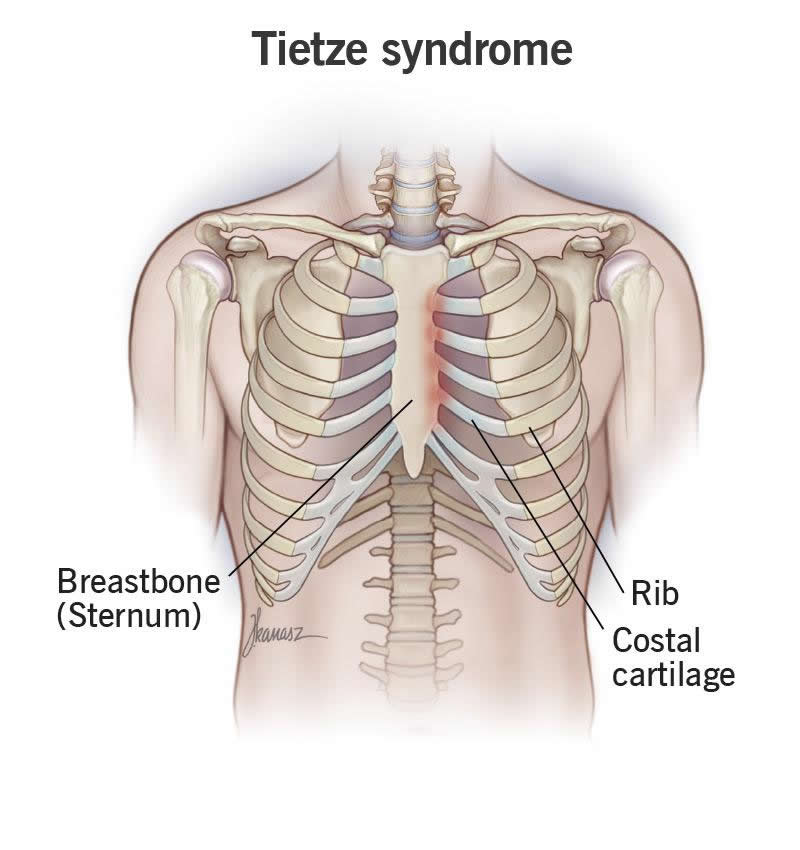Tietze Syndrome
Tietze syndrome is pain and swelling in the cartilage in your rib cage, at the junction where one of your ribs meets your sternum (costochondral junction). Treatment is with rest and pain relievers. It may take a few weeks to months to heal.
Overview

What is Tietze syndrome?
Tietze syndrome (Tietze’s disease) is a rare inflammatory condition that affects the cartilage in your rib cage. It causes musculoskeletal chest pain and swelling at the front and top part of your chest wall.
Your upper ribs (the first 10) have cartilage tips (costal cartilage) where they connect to your sternum (breastbone). The joints where these tips connect (costochondral joints) also have cartilage in them.
General inflammation of the cartilage in your rib cage is called costochondritis. But Tietze syndrome is more specific. It typically affects just one of your top four ribs. It’s also distinctive for causing noticeable swelling.
Healthcare providers aren’t sure what causes Tietze syndrome (also called costochondral junction syndrome). But it doesn’t seem to be serious. You can treat it at home with rest and pain relievers.
Symptoms and Causes
What are Tietze syndrome symptoms?
The most obvious way Tietze syndrome will affect you is by the pain in your chest, which can come on suddenly or gradually. Some say it’s like a dull ache when you’re still, but sharp and gripping when you move or twist your upper body. Coughing, sneezing and exercise can make it worse. You’ll feel it in the front and top of your chest, often on one side. It may also radiate to your arm, shoulder and neck.
Localized swelling is the other major symptom of costochondral junction syndrome. You may see a small, puffy shape somewhere near your upper sternum — most often at your second or third rib. Some people describe it as a “mass” that’s firm to the touch. It may also feel warm and look red or discolored. These are all symptoms of inflammation. Swelling is a distinctive feature of Tietze’s disease, and often the last to fade.
What causes Tietze syndrome?
The symptoms of Tietze syndrome happen because the cartilage at that painful spot in your rib cage is irritated and inflamed. But healthcare providers don’t know what causes this, or why it happens in the particular way that it does. Why does it affect just one of your top few ribs, or produce that characteristic swelling? These are things that distinguish Tietze syndrome from regular costochondritis.
Some of the suggested causes include:
- Traumatic injury. A car accident, fall or sports injury affecting your upper rib cage might cause Tietze’s syndrome. Maybe the soft tissues here just react differently to trauma.
- Microtrauma. Minor but repeated stress on your rib cage over time might trigger a unique inflammatory reaction — like frequent, violent coughing, or getting hit repeatedly in the chest.
Risk factors
You might be more likely to develop Tietze’s disease if you’re recovering from another condition or you have a chronic condition that irritates or weakens the cartilage in your rib cage. Examples include:
- Rheumatic and autoimmune diseases
- Hereditary connective tissue diseases
- Degenerative or inflammatory arthritis
- Chronic chest infections
- Chronic coughing or vomiting
- Recent surgery in the area
Diagnosis and Tests
How is Tietze syndrome diagnosed?
If you go to your healthcare provider with chest pain, they’ll check first to make sure it isn’t a heart attack. After ruling that out, they’ll carefully review your symptoms and examine your chest. They’ll follow up with imaging tests to look for inflammation and signs of injury inside your chest. Healthcare providers diagnose Tietze’s disease when they’ve ruled out other possible causes for your symptoms.
Tests might include:
Management and Treatment
What is the treatment for Tietze syndrome?
When your soft tissues are inflamed, they need time and rest to recover. Healthcare providers usually suggest just that. Over-the-counter pain relievers can help relieve the pain and swelling. Providers often recommend NSAIDs (nonsteroidal anti-inflammatory drugs). You shouldn’t need to miss school or work, but take it easy and avoid vigorous activities while you recover. You can gradually increase your activity as you start to feel better.
Consult your provider if you still feel you need to take NSAIDs after 10 days. Taking them for too long can have side effects. They might suggest switching to acetaminophen, or they might give you a cortisone injection at the site of the inflammation. Some people might need treatment to stop sneezing, coughing or vomiting before their chests can heal. Keep in touch with your provider about your recovery.
Outlook / Prognosis
What can I expect if I have Tietze syndrome?
Costochondral junction syndrome is a temporary condition, and you can expect to make a full recovery. Most people recover in a few weeks, but some bodies take longer. Sometimes, the swelling lingers for several months after the pain goes away. Occasionally, Tietze’s disease comes back after seeming to go away. Different causes and risk factors might make Tietze syndrome more persistent in some cases than others.
A note from Wockr
It’s scary to experience chest pain, especially when you don’t know the cause. But Tietze syndrome isn’t cause for worry. It might be uncomfortable for a while, but you can treat it at home until it gets better.
The biggest challenge with Tietze’s disease may be getting the right diagnosis. It’s rare and resembles many other conditions. Your provider will have to rule these out before diagnosing Tietze syndrome.